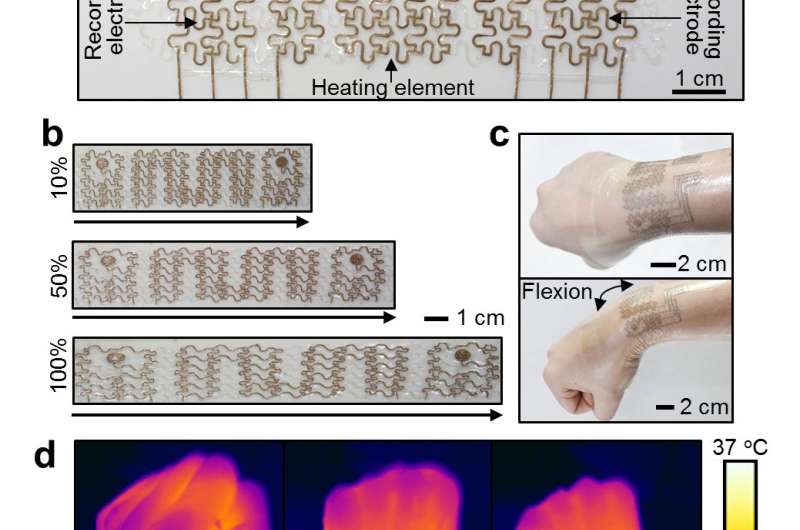

| Date | 14th, Aug 2018 |
|---|
 New wearable device capable of recording the electrical activity of the heart and muscles, as well as delivering therapeutic electrical and thermal stimulations. It is suitable for flexible joints, like the wrist, and allows reliable heat transfer even when the wrist is flexed or extended. Credit: Institute for Basic Science (IBS)
New wearable device capable of recording the electrical activity of the heart and muscles, as well as delivering therapeutic electrical and thermal stimulations. It is suitable for flexible joints, like the wrist, and allows reliable heat transfer even when the wrist is flexed or extended. Credit: Institute for Basic Science (IBS)
A research team at the Center for Nanoparticle Research, within the Institute for Basic Science (IBS), has developed a wearable and implantable device that measures electrophysiological signals and applies electrical and thermal stimulations. It provides information on muscle and cardiac dysfunctions, and thus could be implemented for pain relief, rehabilitation, and prosthetic motor control. As the first soft implant able to record cardiac activity in multiple points of a swine heart, this prototype, described in Nature Nanotechnology, could contribute to the research and production of future bioelectronics.
IBS researchers have used this new device on human skin to record electrocardiogram (ECG) and electromyogram (EMG) data. Thanks to its softness, elasticity and stretchability, it can follow the contours of flexible joints, such as the wrist. Worn on a forearm, it simultaneously monitored EMG signals and delivered electrical and thermal stimulation that could be employed in therapeutic applications.
The research team has also produced a large customized mesh that fits the lower part of a swine heart. Wrapped around the heart, the implant can read signals from the entire organ to identify possible lesions and help recovery. For example, it was able to register the change of the ECG signal caused by an acute heart attack. The mesh is stable during repetitive heart movements and does not interfere with the heart's pumping activity.
"Although various soft cardiac devices have been reported for the rat heart, this study on pigs can approximate human physiology more accurately," says CHOI Suji, first co-author of the study. "We aim to study heart diseases, and stimulate the heart more effectively by synchronizing cardiac pumping activity."
